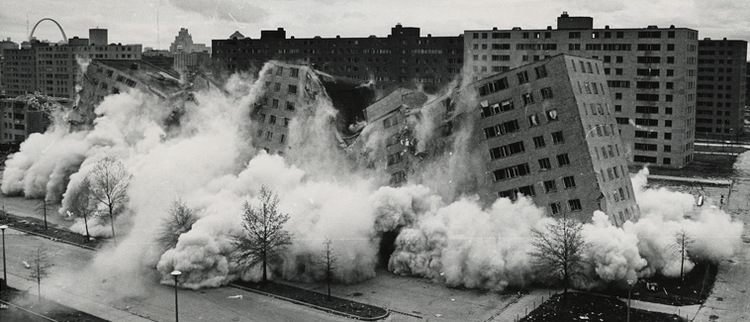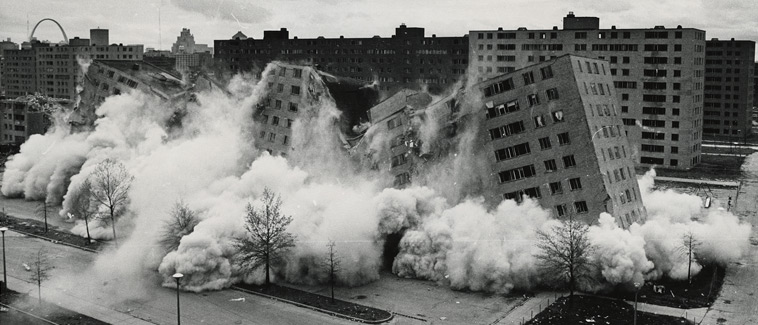
Ferguson Is a Story of the Section 8 Era
By Steve Sailer
08/17/2014
In the optimistic days after WWII, big cities built giant urban housing projects to accommodate the poor. For example, Pruitt-Igoe in St. Louis was designed by Yamasaki, architect of the World Trade Center, on the most advanced principles of modernism. Obviously, taking poor blacks out of their lead paint-encrusted tenements and raising them in advanced Bauhaus designs would prove the bigots wrong.
Pruitt-Igoe went on to be home to the future Heavyweight Champs Leon and Michael Spinks, before it was blown up in 1972.
Pruitt-Igoe, 1972
These days, big cities don’t want to accommodate the black poor anymore; they want them to leave. The powers that be prefer for poor blacks to leave town with Section 8 rent subsidy vouchers that go further in declining suburbs like Ferguson. For example, Hanna Rosin’s 2008 Atlantic cover story American Murder Mystery documented how homicide rates were declining in central Memphis and rising in inner suburbs due to demolition of old housing projects and subsidized relocation of their tenants out of the city.
Poor blacks are the biggest Hot Potato in modern America. Liberal white urbanites realize today that their ancestors made a terrible mistake in the Postwar era by ceding much of the most valuable urban land in America to poor blacks. So they are offloading poor blacks on the less powerful, such as residents of second rate suburbs and of undistinguished small towns. But for this process, in which trillions of dollars of real estate values are at stake, to proceed smoothly without complaints from the less well connected about what is coming their way, it’s important to Control Discourse, to periodically demonize various minor league white people for engaging in pattern recognition.
If you think intelligently, while everybody else had had crimestop pounded into their heads so all thought shuts down when the topic of race comes up, you can make a lot of money in real estate.
The same dynamic is at work in Ferguson in relation to St. Louis. From the St. Louis Post-Dispatch (via Countenance):
Why did the Michael Brown shooting happen here?8 hours ago • By Jesse Bogan • Denise Hollinshed • and Stephen Deere •
FERGUSON • Long before the nation rested its collective conscience on the protests along West Florissant Avenue, there was a different mobilization going on.
Hundreds of people were moving out of their urban neighborhoods to this north St. Louis County suburb seeking a safe and affordable place to live.
They found it in an isolated corner of Ferguson that was flush with sprawling apartment complexes. Far from Ferguson’s leafy residential streets and quaint downtown, many people didn’t even know the apartments were part of the city until young Michael Brown was shot and killed there Aug. 9.
But not the police. They knew.
After decades of relative calm and stability, the apartments have become a tinderbox for crime. Canfield Green Apartments and the nearby Oakmont and Northwinds complexes are a study of the slow encroachment of poverty and social distress into what had been suburban escapes.
Angela Shaver has witnessed that sea change since she moved into Canfield Green Apartments 20 years ago. The state employee said she raised a prom queen there and sent her off to college.
There used to be a swimming pool. Now, there’s a bullet hole in the door below her.
That shooting, and many others, happened long before all the vigil candles melted in the middle of the street for Brown.
Even as Shaver explained the frequency of gunfire, she was cut off by a sudden blast coming from Northwinds Apartments, a hulking spread with more than 400 low-income units.
Boom!
Shaver paused to listen. No screams. No more shots. She picked up the interview where she’d left off.
“I hate to say I got used to them,” she said of the gunshots.
Ferguson’s crime and poverty rate is lower than some of the other North County municipalities. But the small southeast corner of the city where the apartments are glows bright red on crime maps.
That area along West Florissant Avenue and just east of it accounted for 18 percent of all serious crimes reported between 2010 and August 2012, according to a Post-Dispatch analysis of crime data provided by St. Louis County.The area accounted for 28 percent of all burglaries, 28 percent of all aggravated assaults, 30 percent of all motor vehicle thefts and 40 percent of all robberies reported in the city of 21,000 people. …
It’s a cluster of densely populated complexes that stand apart from the predominantly single-family streets of Ferguson.
On a map, the area sticks out like an appendage, one that was added to Ferguson by annexation. Many of the children who live there aren’t even part of the Ferguson-Florissant school system.
Adding to that isolation, police have blocked off nearly all access roads to the apartments with concrete barriers, fences and gates.
The nearly all-white police force has struggled to maintain control and respect from many African-Americans who live there as officers try to clamp down on crime.
There is a common perception that police stop people without reason.
“If you stay here, they basically think you are a thug,” said Gerard Fuller, 19, who is headed to Arkansas Baptist College in a few days on a basketball scholarship.
The Brown shooting dug into that nerve. The response seems to have as much to do with socioeconomic factors as it does opinions about race relations and police brutality in communities across the country that have struggled to integrate.
In St. Louis County alone, African-American poor are six times as likely as white poor to live in areas of concentrated poverty.
The apartment complexes located on the fringe of Ferguson — the self-proclaimed “Community of Choice” — give a glimpse of what that looks like.
The eruption of looting and violent protests and the national attention it drew give a glimpse of the implications.
Some call Ferguson an affordable Kirkwood. …
In the 1960s, Ferguson annexed the land where Brown would be shot by police. He was walking back home to his grandmother’s apartment in the Northwinds complex.
Ashley Nowden, 29, had lived in Northwinds for six years before she hastily moved out in January after being burglarized three separate times. She connects the rise of crimes to an increase in low-income renters.
“It is a younger crowd now,” she said.
Maine-based Eagle Point Companies bought Northwinds in 2005 and poured $12.5 million into refurbishing the complex, thanks in part to low-income housing credits. Part of the deal was that to be eligible to live there, residents can earn no more than 60 percent of the median income in the area.
Northwinds is one of 31 affordable housing properties like it that Eagle Point owns across the U.S.
Laura Burns, president of the company, said she thought crime was under control at Northwinds, but she acknowledged residents tend to be nomadic.
“We have a lot of turnover,” she said. “Some of our residents unfortunately are not in a position to pay the rent for whatever reason.”
Louis Smith, 68, sees the sprawling apartments as yesterday’s high-rise public housing complexes, such as Pruitt-Igoe.
“After they tore these projects down, a lot of people started coming everywhere, everywhere, man,” said Smith, a retired McDonnell Douglas machinist who moved out of Canfield Green in the 1980s to buy a nearby home.
He said his wife, who is involved with the neighborhood watch, has complained to city leaders about unchaperoned and unruly children who come over from the apartments and destroy property.
“The women work,” he said of apartment residents. “The guys stay home, smoke dope and walk around harassing people.
“You can’t say nothing to them,” he added. “They’ll cuss you out.”
Ferguson real estate broker Georgia Rossel also took aim at the apartments.
“Apartments don’t promote community,” said Rossel, who also serves on the planning and zoning board in nearby Jennings. “People are just in and out. They don’t stay.” …
Canfield Green was mostly white when Kevin Edwards and his family moved in 12 years ago. It has since been filled mostly with African-Americans.
Edwards, 50, who is black, gives credit to the complex’s owners for maintaining the property.
“They keep it nice,” he said of neatly trimmed lawns and shrubs.
He says Canfield residents are no different from anyone else. “People here get up in the morning and go to work, try to pay their bills and raise families,” he said.
But the complex attracts a rough element. People with open warrants cruise the sidewalks. And that draws in police. …
Tim Bryant, Steve Giegerich, Walker Moskop and Tim O’Neil, all of the Post-Dispatch, contributed to this report.

